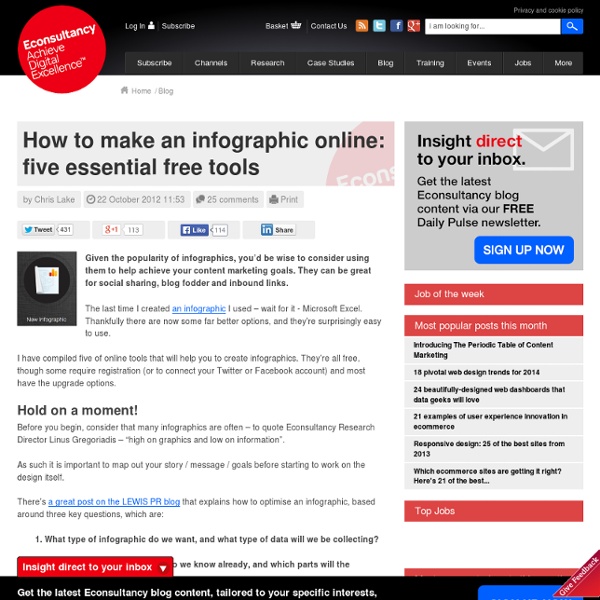Cognitive science
Cognitive science is the interdisciplinary scientific study of the mind and its processes.[1] It examines what cognition is, what it does and how it works. It includes research on intelligence and behavior, especially focusing on how information is represented, processed, and transformed (in faculties such as perception, language, memory, reasoning, and emotion) within nervous systems (human or other animal) and machines (e.g. computers). Cognitive science consists of multiple research disciplines, including psychology, artificial intelligence, philosophy, neuroscience, linguistics, and anthropology.[2] It spans many levels of analysis, from low-level learning and decision mechanisms to high-level logic and planning; from neural circuitry to modular brain organization.
10 Tools for Creating Infographics and Visualizations
The author's posts are entirely his or her own (excluding the unlikely event of hypnosis) and may not always reflect the views of Moz. Hello there! I'm Miranda Rensch, Product Manager at SEOmoz and lover of visual communication.
50 Free Expedient High-Resolution Fabric Textures
Textures serve a big advantage in making websites and other graphics design projects better looking and efficient. Another great thing about it is that you can find it anywhere,in your town, maybe in streets, or even in your homes. Examples of this are fabric textures from your clothes, linen or any fabric materials you have. After capturing the texture it can help your blog in making it more effective and giving it a nice touch. In our next post, we will be showcasing 50 Free Expedient High-Resolution Fabric Textures. We have collected some of the beautiful fabric textures that have different designs for you to choose from.
20+ Tools to Create Your Own Infographics
A picture is worth a thousand words – based on this, infographics would carry hundreds of thousands of words, yet if you let a reader choose between a full-length 1000-word article and an infographic that needs a few scroll-downs, they’d probably prefer absorbing information straight from the infographic. What’s not to like? Colored charts and illustrations deliver connections better than tables and figures and as users spend time looking back and forth the full infographic, they stay on the site longer. Plus, readers who like what they see are more likely to share visual guides more than articles. While not everyone can make infographics from scratch, there are tools available on the Web that will help you create your very own infographics. In this article, we’re listing more than 20 such options to help you get your messages across to your readers, visually.
46 Tools To Make Infographics In The Classroom
Infographics are interesting–a mash of (hopefully) easily-consumed visuals (so, symbols, shapes, and images) and added relevant character-based data (so, numbers, words, and brief sentences). The learning application for them is clear, with many academic standards–including the Common Core standards–requiring teachers to use a variety of media forms, charts, and other data for both information reading as well as general fluency. It’s curious they haven’t really “caught on” in schools considering how well they bridge both the old-form textbook habit of cramming tons of information into a small space, while also neatly overlapping with the dynamic and digital world. So if you want to try to make infographics–or better yet have students make them–where do you start? The 46 tools below, curated by Faisal Khan, are a good place to start.
List of psychic abilities
This is a list of psychic abilities that have been attributed to real-world people. Many of these are also known as extrasensory perception or sixth sense. There is no evidence that psychic abilities exist, and they are not recognized by the scientific community.
15 Free Infographic Design Kits
Here we are presenting some infographics design kits for you that you can download and use for free. With the help of Infographics, you can easily and effectively represent financial data, workflow and processes. However, designing Infographics from the scratch can be a tedious and time consuming task, and for the graphic designers and web designers, time is a precious commodity that they must utilize in the most appropriate manner. In order to create Infographics, you need to draw charts, graphs and diagrams along with icons and symbols that would certainly consume loads of time. On the other hand, if you get these basic elements ready in hand, you can save loads of your precious time. With these useful vector Infographics kits, you can make your job easy for you.
Compiling GIMP 2.8-RC1 for Ubuntu 12.04
1 This tutorial shows you how to compile GIMP 2.8-RC1 on Ubuntu Linux 12.04 (Precise Pangolin). However, you can use it for other GIMP/Linux versions too, because I’ll try to explain how to do it, and not to just tell you the necessary commands so you can compile it but don’t know what you’re doing.If a step doesn’t work as expected or there are required additional steps, please modify the procedure on your own and maybe leave a comment to inform other users about your findings.If there are newer versions available as the ones in the tutorial (for instance, for babl or GEGL), use the newer versions. 2 First, create a temporary directory where the sources are put into:mkdir -p ~/tmp/gimp cd ~/tmp/gimp 3 Then, fetch the source code of the GIMP version you want to compile and put it into the directory.So, either download the GIMP 2.8-RC1 sources and extract it. … check Window / Single-window-mode and it’s ready to use :)
10 Fun Tools To Easily Make Your Own Infographics
People love to learn by examining visual representations of data. That’s been proven time and time again by the popularity of both infographics and Pinterest. So what if you could make your own infographics ? What would you make it of? It’s actually easier than you think… even if you have zero design skills whatsoever.



